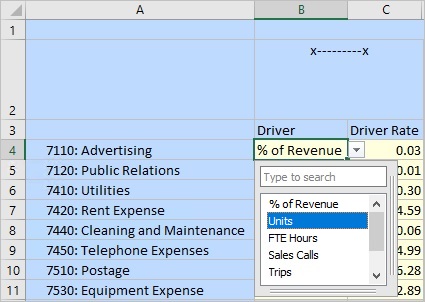Working with Smart Lists
You can enter data using custom drop-down selection lists called Smart Lists, which are accessed from data cells in forms and ad hoc grids.
Data source types: Planning, Planning Modules, Financial Consolidation and Close, Tax Reporting
A Smart List is a drop-down selection list displayed in a form or ad hoc grid cell as an alphanumeric text description, but stored in the database as a number. For example, an integer Smart List for a reporting cycle may have the values 1-5, for Yearly (1), Quarterly (2), Monthly (3), Daily (4), and Hourly (5). The values that are displayed on the form or ad hoc grid are Yearly, Quarterly, Monthly, Daily, and Hourly. When you select one of these values on the form or ad hoc grid, and submit the data, the number associated with it is stored in the database. This means that you do not have to remember the numeric values associated with each time period in the reporting cycle.
In Oracle Smart View for Office, you access Smart Lists from custom drop-down lists in form or ad hoc grid cells. When clicking into cells whose members are associated with a Smart List, you click the down arrow that appears directly to the right of the cell, then select a drop-down list option instead of typing data; in fact, you cannot type in a cell that contains a Smart List.
For example, a data form may contain a Smart List called Justification that provides selections for Research, Customer Feedback, and Expansion. When you click into Account cells named Reason (whose members are associated with the Justification Smart List), a down arrow is displayed. When you click the down arrow, it expands into a drop-down list with the following selections:
- Research
- Customer Feedback
- Expansion
You then select one of the Smart List options as the value for the cell.
To enter a Smart List value in a form or ad hoc grid cell:
-
You cannot type in cells that contain Smart Lists. You must enter data by selecting a value from the Smart List.
-
In forms containing Smart Lists, after deleting all values in a row in order to enter and submit new data, the Smart Lists in that row are empty.
Workaround: Remove row values, and then perform a Submit (that is, you submit
#Missingvalues) or a Refresh. The Smart List drop-down arrows are then displayed properly. Now, you can enter new values for the same row. -
Smart Lists are supported with the HsGetValue and HsSetValue functions. However, with functions, you will not see the Smart List drop-down options. Instead:
-
HsGetValue - Simply retrieves the Smart List value as a string value.
-
HsSetValue - Submits the value as a string value.
-
-
Smart Lists must be set up and enabled by an administrator before you can use them in Smart View. For more information on enabling Smart Lists for forms and ad hoc grids, see the information Smart Lists in the relevant administration guide; for example:
Administering Planning, "Accessing More Administrative Tasks" chapter, Administering Smart Lists


